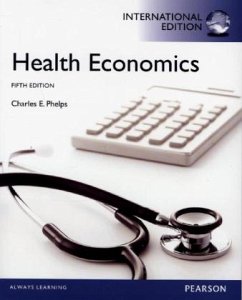Health Economics combines current economic theory, recent research, and health policy problems into a comprehensive overview of the field. This thorough update of a classic and widely used text follows author Charles E. PhelpsÆs thirteen years of service as Provost of the University of Rochester.
Accessible and intuitive, early chapters use recent empirical studies to develop essential methodological foundations. Later chapters build on these core concepts to focus on key policy areas, such as the structure and effects of Medicare reform, insurance plans, and new technologies in the health care community.
This edition contains revised and updated data tables and contains information throughout the text on the latest changes that were made to the Patient Protection and Affordable Care Act (PPACA).
Product Description
Health Economics combines current economic theory, recent research, and health policy problems into a comprehensive overview of the field. This thorough update of a classic and widely used text follows author Charles E. Phelps's thirteen years of service as Provost of the University of Rochester.
Accessible and intuitive, early chapters use recent empirical studies to develop essential methodological foundations. Later chapters build on these core concepts to focus on key policy areas, such as the structure and effects of Medicare reform, insurance plans, and new technologies in the health care community. Features + Benefits
Learning Goals begin each chapter with a bulleted list of topics to be covered so students receive an overview of the core concepts.
Boxes further explain economic concepts mentioned in the text.
End-of-chapter material includes a summary, related references in the classic Handbook of Health Economics, and an expanded set of problems. Suggested answers to select end-of-chapter problems are available on the Companion Website .
An Introduction to Basic Economics Concepts is provided as an appendix to guide students through all the basics they need to know for their health economics course, making the book more accessible to non-majors and lower-level health courses.
Theonline resources make the course easier to teach, including:
An Online Instructor's Manual; and
Companion Website with self-quizzes, links to relevant and timely health economics sites, and answers to select end-of-chapter problems.
Chapter 1. Why Health Economics?
Chapter 2. Utility and Health
Chapter 3. The Transformation of Medical Care to Health
Chapter 4. The Demand for Medical Care: Conceptual Framework
Chapter 5. Empirical Studies of Medical Care Demand and Applications
Chapter 6. The Physician and the Physician-Firm
Chapter 7. Physicians in the Marketplace
Chapter 8. The Hospital as a Supplier of Medical Care
Chapter 9. Hospitals in the Marketplace
Chapter 10. The Demand for Health Insurance
Chapter 11. Health Insurance Supply and Managed Care
Chapter 12. Government Provision of Health Insurance
Chapter 13. Medical Malpractice
Chapter 14. Externalities in Health and Medical Care
Chapter 15. Managing the Market: Regulation, Quality Certification, and Technical Change
Chapter 16. Universal Insurance Issues and International Comparisons of Health Care Systems
Accessible and intuitive, early chapters use recent empirical studies to develop essential methodological foundations. Later chapters build on these core concepts to focus on key policy areas, such as the structure and effects of Medicare reform, insurance plans, and new technologies in the health care community.
This edition contains revised and updated data tables and contains information throughout the text on the latest changes that were made to the Patient Protection and Affordable Care Act (PPACA).
Product Description
Health Economics combines current economic theory, recent research, and health policy problems into a comprehensive overview of the field. This thorough update of a classic and widely used text follows author Charles E. Phelps's thirteen years of service as Provost of the University of Rochester.
Accessible and intuitive, early chapters use recent empirical studies to develop essential methodological foundations. Later chapters build on these core concepts to focus on key policy areas, such as the structure and effects of Medicare reform, insurance plans, and new technologies in the health care community. Features + Benefits
Learning Goals begin each chapter with a bulleted list of topics to be covered so students receive an overview of the core concepts.
Boxes further explain economic concepts mentioned in the text.
End-of-chapter material includes a summary, related references in the classic Handbook of Health Economics, and an expanded set of problems. Suggested answers to select end-of-chapter problems are available on the Companion Website .
An Introduction to Basic Economics Concepts is provided as an appendix to guide students through all the basics they need to know for their health economics course, making the book more accessible to non-majors and lower-level health courses.
Theonline resources make the course easier to teach, including:
An Online Instructor's Manual; and
Companion Website with self-quizzes, links to relevant and timely health economics sites, and answers to select end-of-chapter problems.
Chapter 1. Why Health Economics?
Chapter 2. Utility and Health
Chapter 3. The Transformation of Medical Care to Health
Chapter 4. The Demand for Medical Care: Conceptual Framework
Chapter 5. Empirical Studies of Medical Care Demand and Applications
Chapter 6. The Physician and the Physician-Firm
Chapter 7. Physicians in the Marketplace
Chapter 8. The Hospital as a Supplier of Medical Care
Chapter 9. Hospitals in the Marketplace
Chapter 10. The Demand for Health Insurance
Chapter 11. Health Insurance Supply and Managed Care
Chapter 12. Government Provision of Health Insurance
Chapter 13. Medical Malpractice
Chapter 14. Externalities in Health and Medical Care
Chapter 15. Managing the Market: Regulation, Quality Certification, and Technical Change
Chapter 16. Universal Insurance Issues and International Comparisons of Health Care Systems
